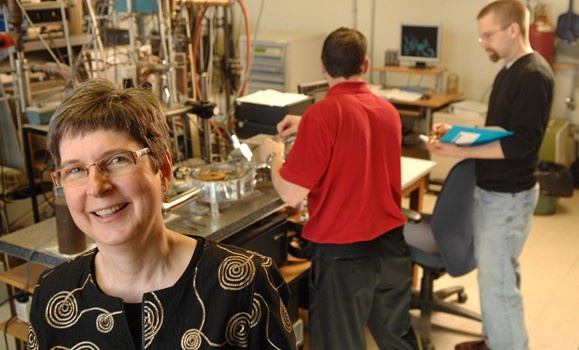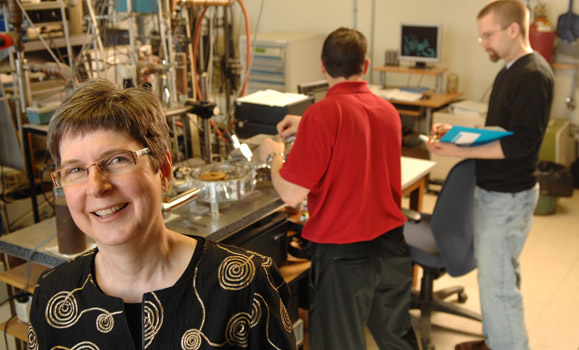Media Releases
» Go to news mainDal chemist discovers new information about elemental boron

HALIFAX, N.S. – Dalhousie chemistry researcher and Royal Society of Canada Fellow Dr. Mary Anne White led a team of researchers to new discoveries about boron (B), the fifth element in the periodic table.
White’s research, recently published in the highly regarded German chemistry journal Angewandte Chemie, discovered which form of boron is stable at room temperature. Before this work, it was unknown. Additionally, boron stands out among other elements because atoms in its stable form were found to be disorderly. Atomic positions in the stable structures of every other element are completely known and ordered in some way.
“Boron’s stable structure has disorder, and that was surprising to learn. Nature likes things more orderly,” explains White, a professor with Dalhousie’s Faculty of Science. “It is especially surprising that the disordered form remains stable at very low temperatures, where matter tends to become more ordered.”
Boron, while not found in its pure elemental form on Earth, is a main component of compounds such as boron nitride and boron carbide. These are the second and third hardest materials in the world, making the element one of the most useful in terms of strength and weight. Only diamond is harder but boron can withstand higher temperatures. Boron compounds are found in aerospace technology, bulletproof vests and cutting tools.
“With this research, we’re providing an underpinning for better understanding of many materials and we’re adding to the fundamental knowledge that’s necessary for the advancement of many technologies and industries,” says White. “All matter is made of elements and there are only about 90-some naturally occurring elements, with about 30 in high abundance. To find out something new about an important element is amazing.”
Dalhousie is one of Canada’s top research universities, producing pioneering research in a wide array of disciplines. It is Atlantic Canada’s only member of the U15 group of Canada’s top research-intensive universities, generating $140 million in funded research annually and hosting 50 Canada Research Chairs.
Images
 |
Dr. Mary Anne White University Research Professor, Faculty of Science Photo Credit: Danny Abriel Download Hi-Res image |
Links
Angewandte Chemie: Determination of Phase Stability of Elemental Boron
Contacts
Nikki Comeau
Communications Officer, Dalhousie University
(902) 494-4189 / (902) 222-8810
nikki.comeau@dal.ca
Nicole LeBlanc
Communications Officer, Faculty of Science
(902) 494-8443
nicole.leblanc@dal.ca
Recent News
- Media release: New $4.3 million grant powers partnership between Atlantic First Nations Water Authority and Dalhousie University to deliver world‑class water treatment
- Media opportunity: Researchers reveal the critical role metabolism plays in reducing the risk of frailty in older adults and how the two are closely linked
- Press Release ‑ Introducing Dalhousie University’s 2024 Board of Governors' Award winners
- Media opportunity: Repeated, small hits to the heads of football players may damage the small blood vessels of the brain: Dalhousie University research
- Media release: Dalhousie‑led initiative awarded $1.9M in federal funding to help agriculture sector meet emission reduction targets
- Dalhousie announces launch of Bringing Worlds Together—a $750‑million campaign for transformational change
- Please join Dalhousie University for a special announcement
- Media opportunity: Dalhousie University researchers find migrant workers in Nova Scotia face discrimination, overcrowded housing and wage theft, but also receive support from their home countries in addressing mistreatment
